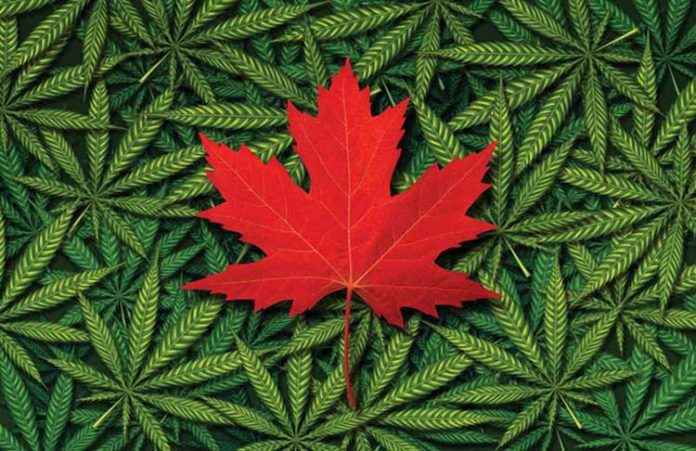Cannabis users aren’t the only ones getting a buzz these days. Over the trailing year, few industries have delivered more robust gains for investors than legal marijuana, with many stocks doubling or tripling in value. ArcView, a leading cannabis researcher, is projecting a compound annual growth rate of 26% through 2021 for North America, meaning we could be talking about almost $22 billion in annual legal weed sales in roughly three years’ time.
Canada is running circles around the U.S.
Yet in spite of this growth, not all North American markets are on equal footing. The U.S. market could easily be the most lucrative for legal weed growers and retailers, but federal law has stamped out any chance that that will happen. In the U.S., the federal government has dug in its heels and maintained a Schedule I classification for pot, making it entirely illegal. This makes it very difficult for cannabis companies in legalized states to get access to any sort of basic banking services, and it disallows them from taking normal corporate deductions when preparing their income taxes.
In comparison, Canada has laid a virtual blueprint for success when it comes to cannabis. Our neighbor to the north legalized medicinal cannabis back in 2001 and has allowed Health Canada to oversee licensing and regulation ever since. In fact, a small handful of Canadian growers has been profitable from the sale of medical cannabis alone.
Even more impressively, Canada is moving forward with legislation that could make it the first developed country to legalize recreational pot — and only the second country in the world to do so, behind Uruguay. Introduced in April 2017 by Prime Minister Justin Trudeau, the bill to green-light recreational weed appears to have the votes needed in parliament given that progressive lawmakers are in the majority. Further, the federal government hashing out a tax-sharing agreement with all of the provinces in recent weeks. Major capacity expansion is also under way by the country’s licensed growers.
By all accounts, Canada looks to lead by example on the cannabis front. When fully ramped up, and assuming legalization does occur by the coming summer, adult-use weed could generate $5 billion in annual sales.
But for as good as the Canadian marijuana industry has been, it could wind up failing consumers after 2019 in the form of higher per-gram pot prices.
A low tax rate should keep pot prices competitive for a year or two
Trudeau’s plan to legalize recreational marijuana centers on the idea of driving out black-market competition, which made up more than 85% of all North American sales in 2016, according to ArcView. To do this, the Canadian federal government proposed taxing cannabis at a lower rate than alcohol. Whereas states in the U.S. are angling to legalize more as a ploy to generate tax revenue for schools and law enforcement, Canada is legalizing to satiate the desires of its public, and to weed out black-market growers and retailers.
The first year or two, post-legalization, will probably be great for Canadian cannabis users. Growers are expected to flood the market with dried cannabis in an effort to grab as much market share as possible. This is why we’ve seen some of the largest growers spending $100 million or more on capacity expansion or acquisitions.
For instance, Canopy Growth Corp., the largest pot stock in the world by market cap, has 2.4 million square feet of greenhouses under construction or in development in British Columbia, with another 1.7 million square feet available for lease. Meanwhile, Aurora Cannabis, announced a $1 billion acquisition of CanniMed Therapeutics last week. The deal should quickly boost Aurora’s cannabis production, which itself is set to soar with the completion of its flagship Aurora Sky project in mid-2018.
Opinion: Canadian cannabis prices could soar after 2019
But things could change after 2019, once growers and retailers have an idea of how much consumers regularly plan to purchase. You see, unlike the U.S. market, which is dominated by small mom-and-pop-sized pot businesses, the Canadian marijuana industry is highly consolidated. Consolidation has been pivotal in keeping production costs down, but it also opens the door to exceptional pricing power for growers and/or retailers. In fact, companies like Canopy Growth and Aurora Cannabis have such bountiful piles of cash on their balance sheets at the moment that flooding the market with dried cannabis and weighing down margins wouldn’t affect them all that much. It would, however, devastate smaller businesses that are counting on strong margins and cash flow to grow, potentially driving them out of the marketplace altogether.
Such a maneuver would be great news for marijuana stock investors who’ve pushed valuations into nosebleed territory. Industry consolidation that lowers costs, coupled with strong pricing power and demand, would be a longer-term recipe for healthy margins. At the same time, it’d be terrible news for consumers and could even threaten to drive a few folks back to the black market, even with a reasonably low tax rate.
This is nothing more than my opinion at this point, and it’s always possible we could see prices fall if growers struggle to get a grip on supply and demand. But I wouldn’t be shocked in the least if Canadian pot prices surge just a year or two after recreational marijuana is legalized.














